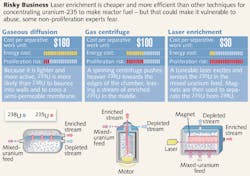Washington, DC--A July 4 Nature news story from Sharon Weinberger says that the U.S. Nuclear Regulatory Commission's decision to open a plant that uses laser-based uranium enrichment will be considered in private. Although the controversial laser uranium-enrichment technology is on the cusp of making it cheaper to create fuel for nuclear power plants, some non-proliferation experts are concerned that the efficiency of the laser-based technology will also smooth the path for bomb makers.
The article says that on July 11, the Atomic Safety and Licensing Board of the US Nuclear Regulatory Commission (NRC) will hold a final hearing on a proposal by General Electric (GE; Fairfield, CT) and Hitachi (Tokyo, Japan), to build the first commercial laser-enrichment plant in Wilmington, NC. A decision on the plant is anticipated in September and is widely expected to be favorable; however, the last public hurdle for the venture will be conducted in secret. "Although we would like to keep it as transparent as possible, the only practical thing to do with this mandatory review is to close this hearing in its entirety to the public," says Paul Ryerson, one of the NRC's administrative judges.
Separating the tiny fraction of uranium-235 from the uranium-238 that dominates natural uranium is the major hurdle to making fuel for commercial reactors and fissile material for weapons. Separation of Isotopes by Laser Excitation, or SILEX, a proprietary technique being developed by GE, promises to be much cheaper than either gaseous diffusion or gas centrifuging, two techniques currently in use that date back to the Manhattan Project. Although the exact details of SILEX are classified, the principles are well understood: a laser tuned to a specific frequency excites and ionizes the uranium-235 in a gaseous form of uranium, so that the charged atoms can be siphoned off.
But many scientists and non-proliferation experts are concerned that a viable commercial facility would encourage countries wishing to start bomb projects. The American Physical Society in College Park, MD, for example, has lodged a petition with the NRC, urging the commission to review proliferation risks for all licenses. The society says that laser enrichment could be a "game changer" for those wanting to pursue proliferation, because it would fit into compact facilities—just one-quarter of the size of a centrifuge plant—and would therefore be difficult to detect through surveillance.
Former NRC commissioners disagree on whether the licensing process weighs up the proliferation risks carefully enough. Dale Klein, who was a commissioner during the early days of the GE–Hitachi proposal, says that proliferation risks were carefully considered for such applications. He notes, for example, that input was sought from the US defense department. But Victor Gilinsky, another former commissioner, says that other agencies involved in assessing proliferation risks were not regularly consulted. Gilinsky sees a tension between the United States' goal of safely commercializing nuclear-power technology and its efforts to control the proliferation of nuclear materials. "They are at cross purposes," he says. "When there's a conflict, generally speaking, the policy to spread nuclear technology overrides the non-proliferation policy."
GE spokesman Michael Tetuan says that the planned safeguards for the facility, such as measures to protect classified information, exceed the government's requirements. He also points to a report by an external panel, commissioned by GE but not made public, which concluded that laser enrichment poses no greater proliferation risk than the other enrichment methods.
Donald Kerr, a former director of Los Alamos National Laboratory in New Mexico, who was a member of that panel, disagrees with the assessment that a laser facility would be smaller and more difficult to detect. The critics, he says, are relying on "marketing projects" from the 1980s that may have oversold the small footprint of the technology. "We had access to the actual information about the full-scale plant," says Kerr. The proposed plant would occupy 0.5 square km. Kerr also dismisses concerns about industrial espionage. "There's never been an American A. Q. Khan," he says, referring to the Pakistani nuclear scientist who stole industrial centrifuge secrets from the URENC4O plant in the Netherlands, notoriously creating a nuclear black market.
Henry Sokolski, executive director of the Nonproliferation Policy Education Center in Washington DC, says that proliferation risks are harder to avoid than industrial espionage; the plant itself could simply spur other countries to follow suit and pursue their own research. "The most sensitive technology leak has already occurred," says Sokolski. "And it's that this stuff can work."
SOURCE: Nature news; www.nature.com/news/laser-plant-offers-cheap-way-to-make-nuclear-fuel-1.10945

